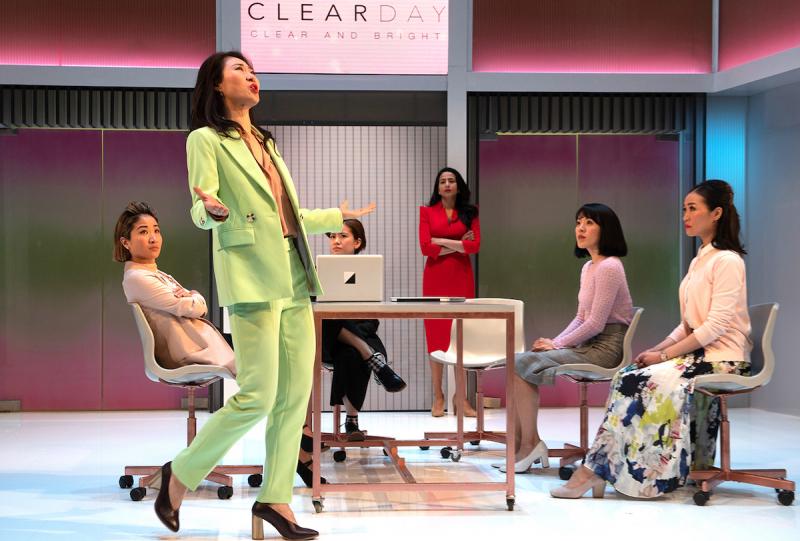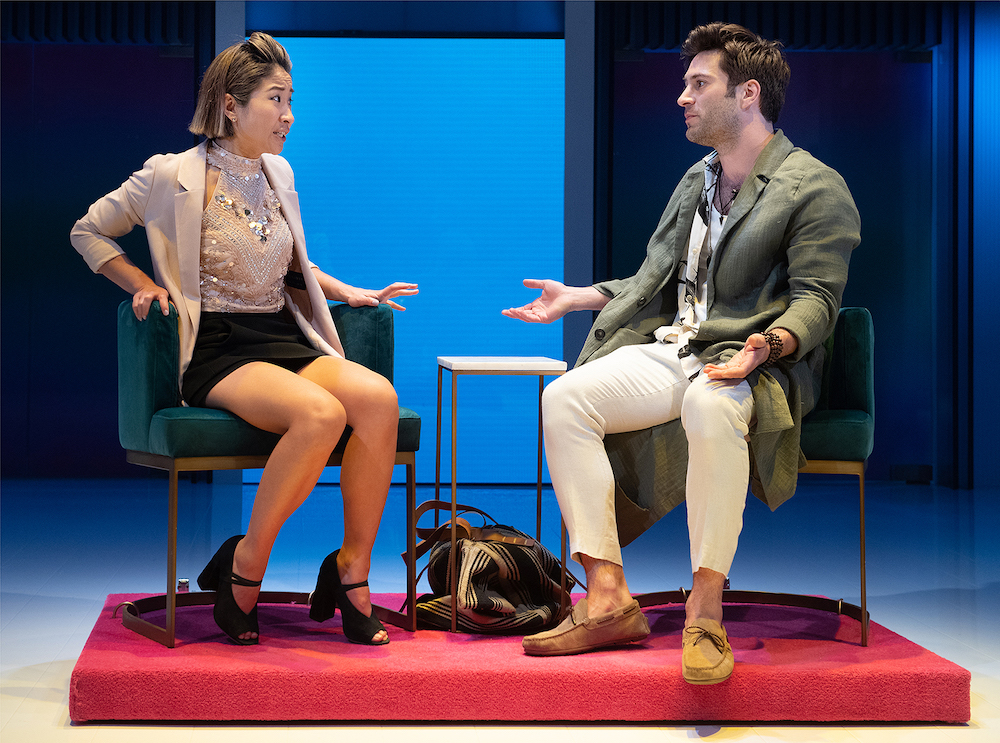White Pearl, Royal Court review - comic racial stereotypes | reviews, news & interviews
White Pearl, Royal Court review - comic racial stereotypes
White Pearl, Royal Court review - comic racial stereotypes
New satire about the cosmetics industry and race is only mildly funny

Artistic Director Vicky Featherstone's commitment to staging a diversity of new voices is very laudable, and with White Pearl she has found a show that is original in setting, if not in theme. Written by Anchuli Felicia King, a New York-based, multidisciplinary artist of Thai-Australian descent, this international playwriting debut is a comic satire on the cosmetics industry and race in a South-East Asian setting.
In the Singapore office of Clearday, a new global cosmetic brand that aims to whiten women's skin, there is panic when an early version of the company's latest skin cream video advert is stolen and uploaded on YouTube. Priya, the founding director, is planning a response with Sunny, her assistant, and there's a sense that they are desperately slamming the stable door after the horse has long bolted. As the video, which is clearly racist in its depiction of the effects of White Pearl whitening cream, goes viral, help comes from the company chemicals expert, Soo-Jin, who demonstrates that its content might actually help sales of their product.
It is only mildly interesting, mildly well written and mildly amusing
At first, King tells the story of this PR disaster by focusing on three pairs of characters: Priya and Sunny; Soo-Jin and Xiao, who is responsible for the advert; and office comedian Built and her ex-lover Marcel, a Frenchman who is responsible for the hack. But it soon becomes clear that the location and the story is really just an excuse to bring together a group of different Pan Asians, and explore their racial prejudices. So Priya is Indian-Singaporean, Sunny is Chinese-Singaporean and speaks dudebro American, Soo-Jin is South Korean, Xiao is Chinese and Built Thai-American, Californian even. And they are joined by Japanese Ruki.
As the tensions in the Clearday office rise, with mutual recriminations burning everybody's eardrums, the air is soon thick with racial epithets. Each character comically represents their nation of origin, and a lot of the play's humour comes from cultural misunderstandings and clashing stereotypes. So Xiao's father is a corrupt Chinese official while Japanese Ruki is shown as painfully modest; there is a long passage all about the anti-black prejudice of some South Asians; by the end, Priya's Mumbai pride goes head-to-head with Soo-Jin's Korean intelligence. The trouble is that this satirical game of stereotypes sits uneasily with the dumb female jokes, and that the sitcom-style comedy tends to overwhelm the darker themes of racism, cosmetics and female self-esteem.
 At its best, the play illuminates the complexity of people's ideas about skin colour and about racial and cultural characteristics. It challenges the Western idea that Asians and South East Asians are all the same, and it articulates several different notions of prejudice — and it does this without being overtly preachy or overly explicit. The notion that whiter skin colour is better than darker gets a sharp criticism, and the manipulative activities of advertising in the cosmetics industry is also parodied and condemned. Likewise, the craziness of the digital world, with its tyranny of likes, and the hilarious mix of comments that viral videos attract is well represented. And the mostly light-hearted ambiance of the play is itself a comment on the politics of humour.
At its best, the play illuminates the complexity of people's ideas about skin colour and about racial and cultural characteristics. It challenges the Western idea that Asians and South East Asians are all the same, and it articulates several different notions of prejudice — and it does this without being overtly preachy or overly explicit. The notion that whiter skin colour is better than darker gets a sharp criticism, and the manipulative activities of advertising in the cosmetics industry is also parodied and condemned. Likewise, the craziness of the digital world, with its tyranny of likes, and the hilarious mix of comments that viral videos attract is well represented. And the mostly light-hearted ambiance of the play is itself a comment on the politics of humour.
Although there are some fun exchanges, such as the toilet scene in which Soo-Jin teaches Xiao to call the office's "American British schoolgirls" "bitches", and the scenes between Built and Marcel (pictured above) have a sharply realized sense of gender politics, the best adjective to describe White Pearl is "mild", rather than, say, ferocious. It is mildly interesting, mildly well written and mildly amusing. The plot of the 85-minute piece is quite slight and unconvincing, and the joy of the transgressive jokes soon begins to pall. Yes, the whole play does have a brightness of dialogue and clarity of humour, but none of the characters are explored deeply enough to be compelling. It's hard to care about anyone.
American director Nana Dakin's production is entertainingly shiny, with a well-lit office set designed by Moi Tran and Ian William Galloway's projections of internet comments and rapidly escalating YouTube views livening up the action. The ensemble cast is confidently led by Farzana Dua Elahe (Priya) and Minhee Yeo (Soo-Jin), with vivid contributions from Kae Alexander (Built) and Harry Potter and Chimerica star Katie Leung (Sunny), and solid work from Momo Yeung (Xiao) and Kanako Nakano (Ruki). Televison and film actor Arty Froushan makes an excellent stage debut as Marcel. But despite the attractive sheen of this office sitcom, and the glancing insights that occur along the way, the play can't quite shake off its superficial feel. As Sunny says, "ai-ya!"
rating
Explore topics
Share this article
The future of Arts Journalism
You can stop theartsdesk.com closing!
We urgently need financing to survive. Our fundraising drive has thus far raised £33,000 but we need to reach £100,000 or we will be forced to close. Please contribute here: https://gofund.me/c3f6033d
And if you can forward this information to anyone who might assist, we’d be grateful.

Subscribe to theartsdesk.com
Thank you for continuing to read our work on theartsdesk.com. For unlimited access to every article in its entirety, including our archive of more than 15,000 pieces, we're asking for £5 per month or £40 per year. We feel it's a very good deal, and hope you do too.
To take a subscription now simply click here.
And if you're looking for that extra gift for a friend or family member, why not treat them to a theartsdesk.com gift subscription?
more Theatre
 Letters from Max, Hampstead Theatre review - inventively staged tale of two friends fighting loss with poetry
Sarah Ruhl turns her bond with a student into a lesson in how to love
Letters from Max, Hampstead Theatre review - inventively staged tale of two friends fighting loss with poetry
Sarah Ruhl turns her bond with a student into a lesson in how to love
 Elephant, Menier Chocolate Factory review - subtle, humorous exploration of racial identity and music
Story of self-discovery through playing the piano resounds in Anoushka Lucas's solo show
Elephant, Menier Chocolate Factory review - subtle, humorous exploration of racial identity and music
Story of self-discovery through playing the piano resounds in Anoushka Lucas's solo show
 This is My Family, Southwark Playhouse - London debut of 2013 Sheffield hit is feeling its age
Relatable or stereotyped - that's for you to decide
This is My Family, Southwark Playhouse - London debut of 2013 Sheffield hit is feeling its age
Relatable or stereotyped - that's for you to decide
 The Frogs, Southwark Playhouse review - great songs save updated Aristophanes comedy
Tone never settles, but Sondheim's genius carries the day
The Frogs, Southwark Playhouse review - great songs save updated Aristophanes comedy
Tone never settles, but Sondheim's genius carries the day
 Mrs Warren's Profession, Garrick Theatre review - mother-daughter showdown keeps it in the family
Shaw's once-shocking play pairs Imelda Staunton with her real-life daughter
Mrs Warren's Profession, Garrick Theatre review - mother-daughter showdown keeps it in the family
Shaw's once-shocking play pairs Imelda Staunton with her real-life daughter
 The Crucible, Shakespeare's Globe review - stirring account of paranoia and prejudice
Ince's fidelity to the language allows every nuance to be exposed
The Crucible, Shakespeare's Globe review - stirring account of paranoia and prejudice
Ince's fidelity to the language allows every nuance to be exposed
 The Fifth Step, Soho Place review - wickedly funny two-hander about defeating alcoholism
David Ireland pits a sober AA sponsor against a livewire drinker, with engaging results
The Fifth Step, Soho Place review - wickedly funny two-hander about defeating alcoholism
David Ireland pits a sober AA sponsor against a livewire drinker, with engaging results
 The Deep Blue Sea, Theatre Royal Haymarket review - Tamsin Greig honours Terence Rattigan
The 1952 classic lives to see another day in notably name-heavy revival
The Deep Blue Sea, Theatre Royal Haymarket review - Tamsin Greig honours Terence Rattigan
The 1952 classic lives to see another day in notably name-heavy revival
 The Brightening Air, Old Vic review - Chekhov jostles Conor McPherson in writer-director's latest
The Irishman's first new play in over a decade is engaging but overstuffed
The Brightening Air, Old Vic review - Chekhov jostles Conor McPherson in writer-director's latest
The Irishman's first new play in over a decade is engaging but overstuffed
 1536, Almeida Theatre review - fast and furious portrayal of women in Henry VIII's England
This wild, intelligent play is a tour de force till the doom-laden finale
1536, Almeida Theatre review - fast and furious portrayal of women in Henry VIII's England
This wild, intelligent play is a tour de force till the doom-laden finale
 The Comedy About Spies, Noel Coward Theatre review - 'Goes Wrong' team hit the spot again
More mayhem from the Mischief company
The Comedy About Spies, Noel Coward Theatre review - 'Goes Wrong' team hit the spot again
More mayhem from the Mischief company
 House of Games, Hampstead Theatre review - adapted Mamet screenplay entertains but is defanged
Richard Bean has turned Mamet's steel trap into an amusing puzzle
House of Games, Hampstead Theatre review - adapted Mamet screenplay entertains but is defanged
Richard Bean has turned Mamet's steel trap into an amusing puzzle

Add comment